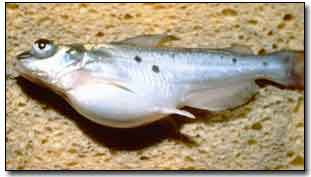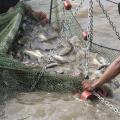Diseases of Catfish
The "low-intensity" management practices used prior to the 1980's generally resulted in good pond water quality and lower overall stress on fish populations. Lower fish densities also meant less efficient transmission of disease organisms. Over the years, stocking and feeding rates steadily increased and producers adopted a multiple-batch cropping system wherein new populations of fingerlings were stocked into ponds with existing populations of larger fish. These production practices lead to the emergence of infectious diseases as the primary limiting factor in catfish production, and disease outbreaks are not uncommon even on well-run facilities.
 About 45 percent of inventory losses on catfish fingerling farms are attributable to infectious diseases. Corresponding survey data for food-sized fish are lacking. Of the overall catfish losses caused by infectious disease, approximately 60 percent are the result of single or mixed bacterial infections, 30 percent result from parasitic infestation, 9 percent from fungal infections, and 1 percent are of viral etiology. Multiple or mixed infections often occur in pond raised channel catfish making treatment decisions difficult.
About 45 percent of inventory losses on catfish fingerling farms are attributable to infectious diseases. Corresponding survey data for food-sized fish are lacking. Of the overall catfish losses caused by infectious disease, approximately 60 percent are the result of single or mixed bacterial infections, 30 percent result from parasitic infestation, 9 percent from fungal infections, and 1 percent are of viral etiology. Multiple or mixed infections often occur in pond raised channel catfish making treatment decisions difficult.
Economic losses resulting from infectious diseases are difficult to quantify because record keeping varies among farmers and many diseases go unreported. Nevertheless, infectious disease is believed to cost producers many millions of dollars in direct fish losses each year. In addition, infectious diseases influence profitability by increasing treatment costs, reducing food consumption by fish, increasing feed conversion ratios, and causing harvesting delays. Fish-eating birds may also be attracted to ponds with sick and dying fish causing further losses.
There are several disease syndromes for which the etiology remains in question, such as channel catfish anemia (CCA), which has also been referred to as "no blood disease". Another syndrome is visceral toxicosis of catfish (VTC), believed to be caused by a toxin.
Once a disease outbreak occurs, effective health management requires three basic steps: problem identification, diagnosis, and corrective management--all of which must be performed in a timely manner to avoid further losses. Whenever multiple factors contribute to the disease process, it makes the diagnosis more difficult and often complicates corrective management.
MSU Publications & Information
- Catfish Vaccine Research Targets #1 Disease
MAFES Research Highlights Summer 1997 - Vaccine Work Aims to Improve Animal Health
MAFES Research Highlights Summer 2001 - Parasite Threatens Mississippi Catfish
MAFES Highlights Spring 2000
Other Catfish Disease Information
- Infestations of the Trematode Bolbophorus sp. in Channel Catfish
SRAC Fact Sheet No. 1801 - Calculating Treatments for Ponds and Tanks
SRAC Fact Sheet No. 410 - The Role of Stress in Fish Disease
SRAC Fact Sheet No. 474 - Proliferative Gill Disease (Hamburger Gill Disease)
SRAC Fact Sheet No. 475 - Ich (White Spot Disease)
SRAC Factsheet No. 476 - ESC - Enteric Septicemia of Catfish
SRAC Factsheet No. 477 - Aeromonas Bacterial Infections - Motile Aeromonad Septicemia
SRAC Factsheet No. 478 - Columnaris Disease: A Bacterial Infection Caused by Flavobacterium columnare
SRAC Factsheet No. 479b - Saprolegniasis (Winter Fungus) and Branchiomycosis of Commercially Cultured Channel Catfish
SRAC Factsheet No. 4700 - Protozoan Parasites
SRAC Factsheet No. 4701 - Channel Catfish Virus Disease
SRAC Factsheet No. 4702 - Additional Southern Regional Aquaculture Center Fact Sheets
Publications
News
STARKVILLE, Miss.
Coastal wetland conservation and restoration projects along the Mississippi Gulf Coast and beyond are running into a distinct challenge: there often aren’t enough locally sourced native plants readily available to complete these efforts.
The Mississippi State University Extension Service is meeting this problem head-on by enlisting plant enthusiasts to grow and sell these marsh plants. The effort is organized as the Native Plant Producer Network, or NPPN, and it was started in 2023.
STARKVILLE, Miss. -- Lower feed prices are providing some relief to Mississippi’s catfish producers, but many are still facing more than their share of obstacles just to break even.




